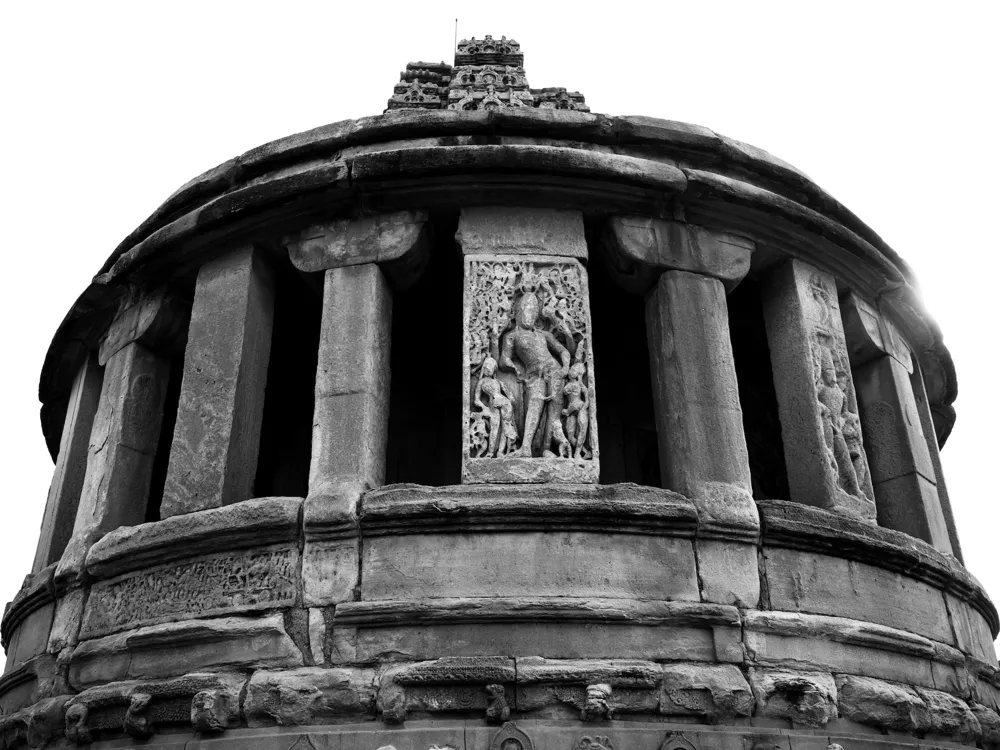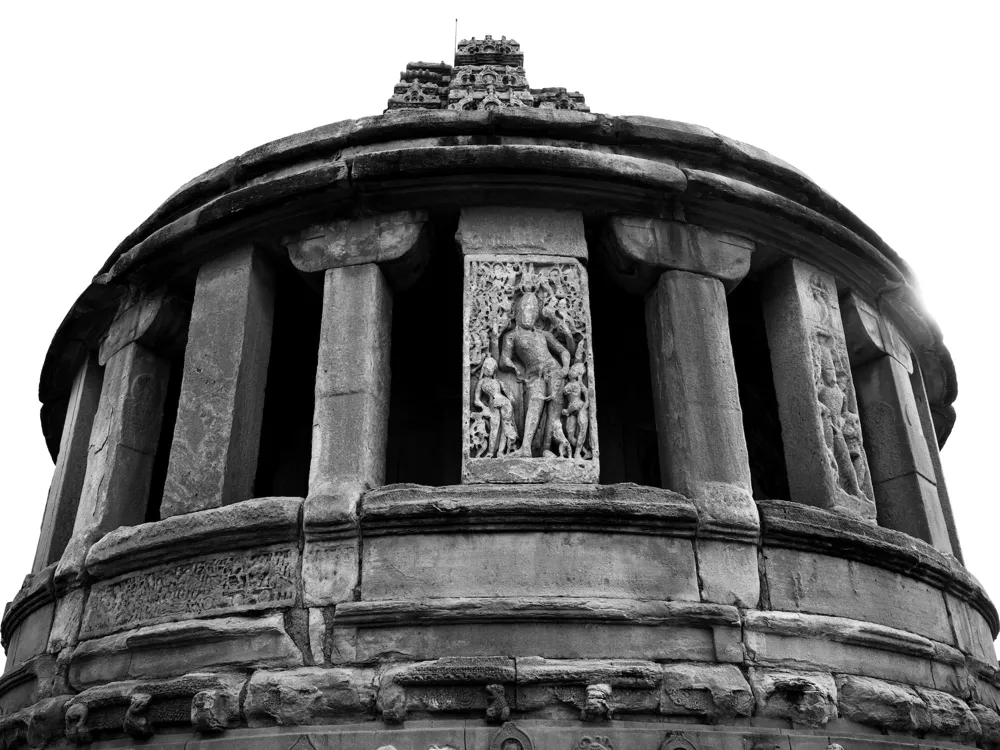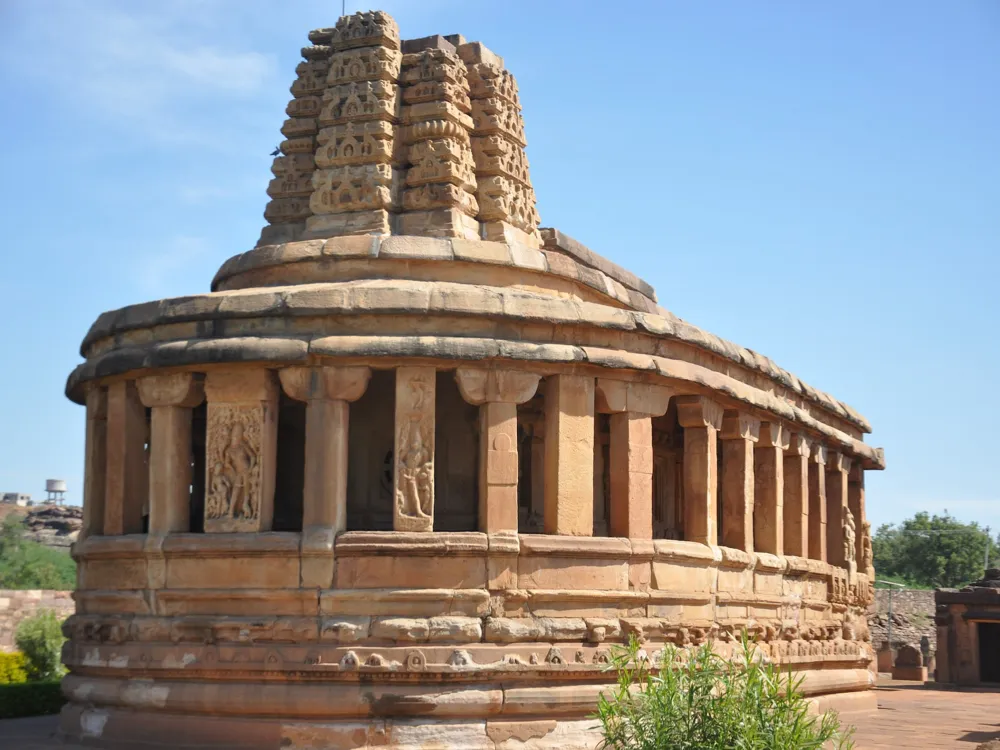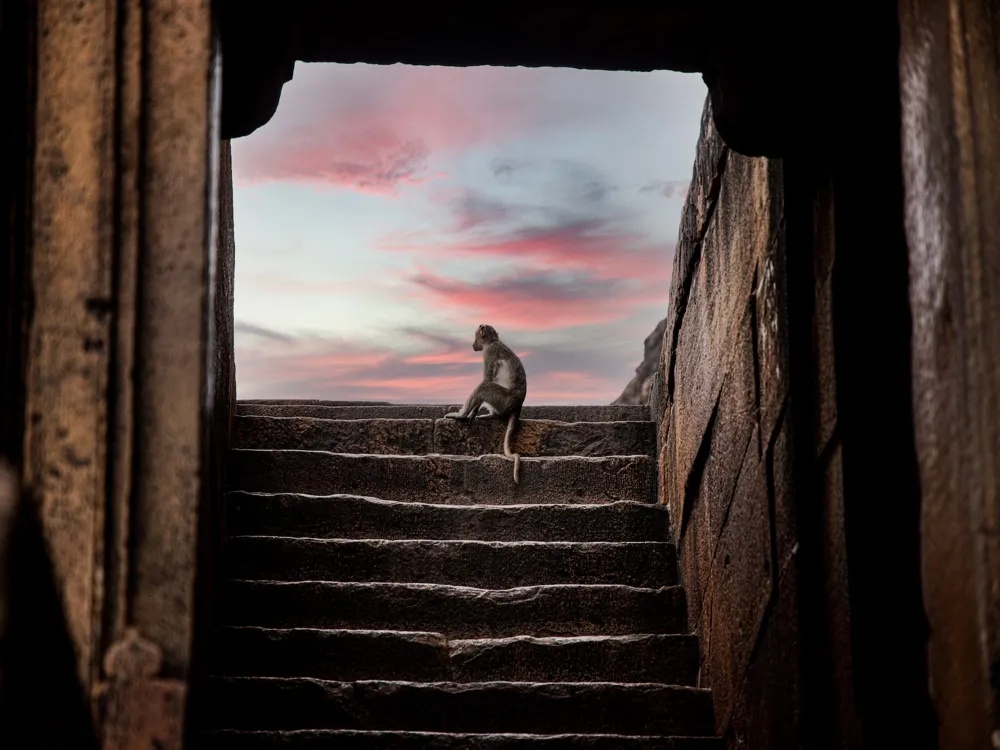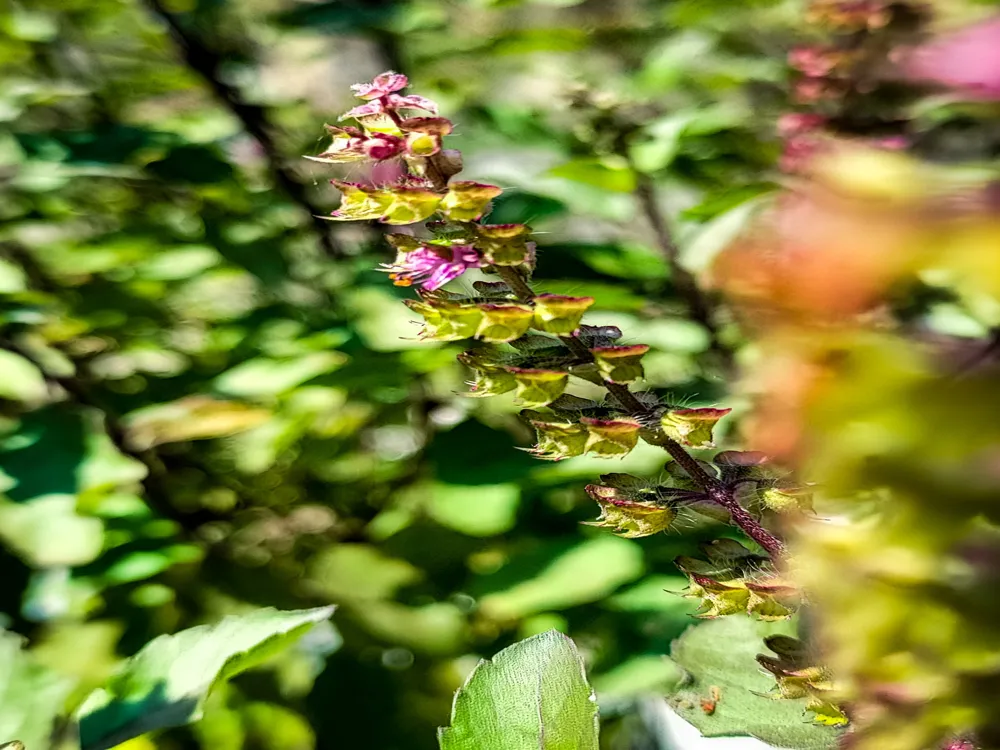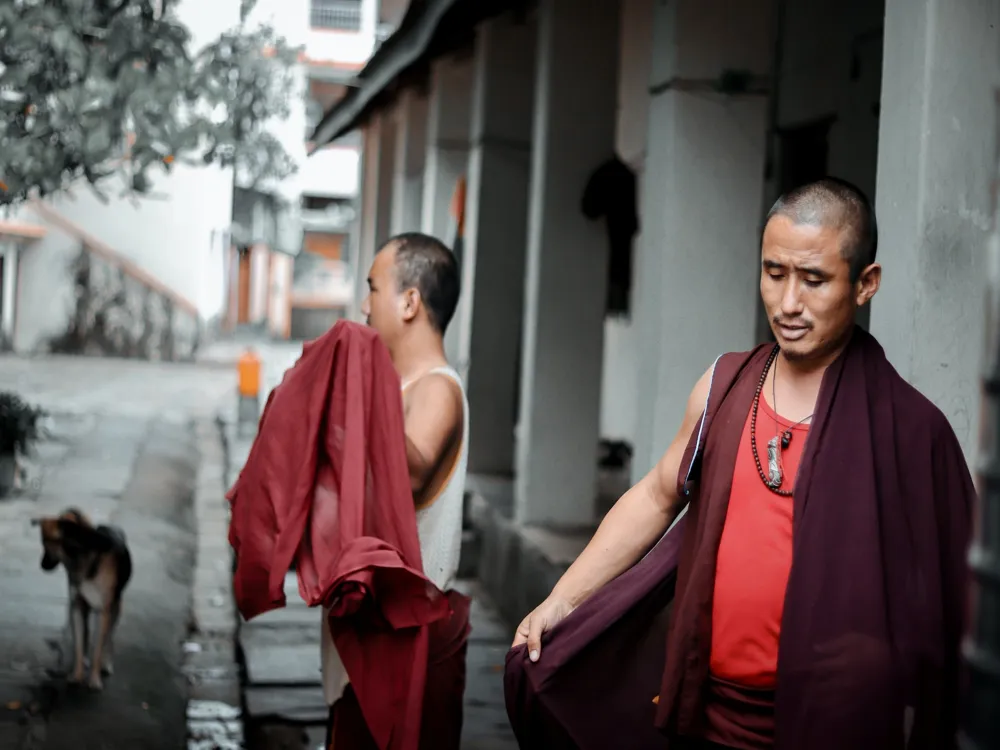The Suryanarayana Temple, nestled in the historic town of Aihole in Karnataka, India, is a magnificent example of ancient Indian architecture. This temple, dedicated to the Sun God, Surya, stands as a testament to the architectural ingenuity of the Chalukyan era. Aihole, often referred to as the 'Cradle of Indian Architecture', hosts this temple as one of its most distinguished monuments. Steeped in history, the Suryanarayana Temple is believed to have been constructed in the 7th or 8th century CE. It showcases the transition in architectural styles, from the rock-cut temples to the later structural edifices. The temple is renowned for its intricately carved sculptures and the remarkable use of sandstone in its construction. The deity of Surya in a chariot, drawn by horses, is the focal point of this spiritual site, captivating visitors with its artistic brilliance. Over the years, the temple has attracted historians, art enthusiasts, and spiritual seekers alike. Its unique design, characterized by a blend of various architectural styles, offers a fascinating glimpse into India's past. The Suryanarayana Temple is not just a place of worship, but a symbol of the rich cultural heritage and architectural prowess of ancient India. The Suryanarayana Temple of Aihole is an architectural marvel, reflecting the mastery of the Chalukyan architects. The temple's structure is a harmonious blend of Dravidian and Nagara styles, indicative of the period's experimentation with different architectural forms. The temple's most striking feature is its apsidal end, a rarity in Indian temple architecture, typically associated with Buddhist chaitya halls. The temple stands on a raised platform, with a distinctive sanctum sanctorum (garbhagriha), an antarala (vestibule), a sabha mandapa (assembly hall), and a mukha mandapa (entrance hall). The walls of the temple are adorned with exquisite carvings depicting scenes from Hindu mythology, including the epics Ramayana and Mahabharata. The detailed sculptures of gods, goddesses, and mythical creatures add to the temple's splendor. One of the remarkable aspects of the Suryanarayana Temple is its use of light. The architects skillfully positioned the windows and openings to ensure that the sanctum receives ample natural light, highlighting the intricacies of the deity sculpture. The fusion of artistic elements with architectural science makes this temple a significant study for historians and architects alike. Visitors are advised to dress conservatively, respecting the temple's cultural and spiritual significance. Traditional or modest attire is preferred. While photography may be allowed in certain areas, it is restricted inside the main sanctum. Visitors should check for signs or consult with temple authorities. Opting for a guided tour can enhance the experience, providing insightful details about the temple's history, architecture, and cultural relevance. Visitors should be mindful of local customs, such as removing shoes before entering the temple and observing silence within the sacred premises. The best time to visit the temple is during the cooler months, from October to March, for a more comfortable experience. The Suryanarayana Temple in Aihole is accessible by various modes of transportation. The nearest major city is Bagalkot, approximately 34 kilometers away. Visitors can reach Aihole via road, as it is well-connected by bus services from major cities like Bengaluru, Hubli, and Belgaum. The nearest railway station is in Badami, around 22 kilometers from Aihole. For those preferring air travel, the nearest airport is Hubli Airport, from where one can hire taxis or take buses to reach the temple. Read More:Overview of Suryanarayana Temple, Aihole, Karnataka
Architecture of Suryanarayana Temple
Tips When Visiting Suryanarayana Temple
Dress Appropriately
Photography Restrictions
Guided Tours
Local Etiquette
Best Time to Visit
How To Reach Suryanarayana Temple
Suryanarayana Temple
Aihole
Karnataka
NaN onwards
View aihole Packages
Aihole Travel Packages
View All Packages For Aihole
Top Hotel Collections for Aihole

Private Pool

Luxury Hotels

5-Star Hotels

Pet Friendly
Top Hotels Near Aihole
Other Top Ranking Places In Aihole
View All Places To Visit In aihole
Faq on Aihole
What is the significance of Suryanarayana Temple in Aihole?
The Suryanarayana Temple in Aihole holds immense significance as one of the oldest temples dedicated to the Sun God, Surya. It showcases exemplary Chalukyan architecture and stands as a testimony to the rich cultural and religious heritage of the region.
When was the Suryanarayana Temple built in Aihole?
The exact date of construction of the Suryanarayana Temple in Aihole is not precisely known, but it is believed to have been built during the 7th or 8th century CE, during the Chalukya dynasty's reign.
What architectural style is the Suryanarayana Temple in Aihole known for?
The Suryanarayana Temple in Aihole is renowned for its unique blend of architectural styles, primarily featuring elements of early Chalukyan architecture with influences from Dravidian and Nagara styles.
Is the Suryanarayana Temple in Aihole still in use for religious purposes?
Yes, the Suryanarayana Temple in Aihole is still actively used for religious purposes. Devotees visit the temple to offer prayers to the Sun God, Surya, and seek blessings for prosperity and well-being.
What are some notable features of the Suryanarayana Temple in Aihole?
The Suryanarayana Temple in Aihole boasts several notable features, including intricate carvings depicting various Hindu deities and mythological scenes, a sanctum dedicated to the Sun God, intricately carved pillars, and a distinct vimana (tower) structure.
View aihole Packages
Aihole Travel Packages
View All Packages For Aihole
Top Hotel Collections for Aihole

Private Pool

Luxury Hotels

5-Star Hotels

Pet Friendly
Top Hotels Near Aihole
Other Top Ranking Places In Aihole
Faq on Aihole
What is the significance of Suryanarayana Temple in Aihole?
The Suryanarayana Temple in Aihole holds immense significance as one of the oldest temples dedicated to the Sun God, Surya. It showcases exemplary Chalukyan architecture and stands as a testimony to the rich cultural and religious heritage of the region.
When was the Suryanarayana Temple built in Aihole?
The exact date of construction of the Suryanarayana Temple in Aihole is not precisely known, but it is believed to have been built during the 7th or 8th century CE, during the Chalukya dynasty's reign.
What architectural style is the Suryanarayana Temple in Aihole known for?
The Suryanarayana Temple in Aihole is renowned for its unique blend of architectural styles, primarily featuring elements of early Chalukyan architecture with influences from Dravidian and Nagara styles.
Is the Suryanarayana Temple in Aihole still in use for religious purposes?
Yes, the Suryanarayana Temple in Aihole is still actively used for religious purposes. Devotees visit the temple to offer prayers to the Sun God, Surya, and seek blessings for prosperity and well-being.
What are some notable features of the Suryanarayana Temple in Aihole?
The Suryanarayana Temple in Aihole boasts several notable features, including intricate carvings depicting various Hindu deities and mythological scenes, a sanctum dedicated to the Sun God, intricately carved pillars, and a distinct vimana (tower) structure.








